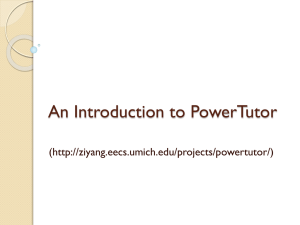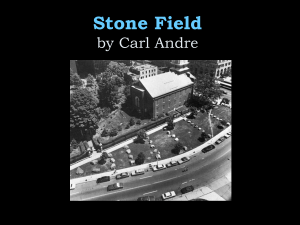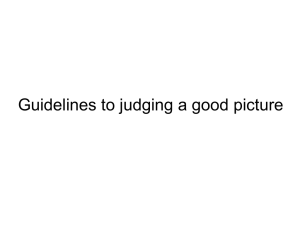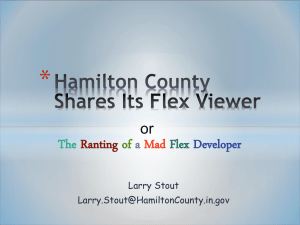CRV Glossary - Mindwise Consulting
advertisement
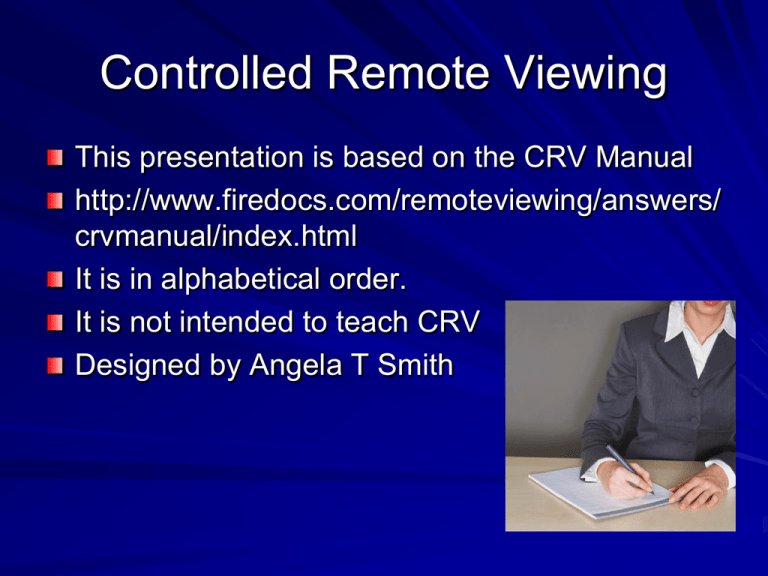
Controlled Remote Viewing This presentation is based on the CRV Manual http://www.firedocs.com/remoteviewing/answers/ crvmanual/index.html It is in alphabetical order. It is not intended to teach CRV Designed by Angela T Smith Controlled Remote Viewing Protocol designed by Ingo Swann in conjunction with Hal Puthoff and the staff of Stanford Research Institute (SRI) International Original DIA manual written by Paul Smith Published by P.J. Gaenir at Firedocs.com Controlled Remote Viewing Serves as a comprehensive explanation of the theory and mechanics of coordinate remote viewing - later to be known as Controlled Remote Viewing or CRV Intended for individuals who have no knowledge of psychoenergetic technology Intended as a guide for training programs Admonitions Specific Glossary of specific terms Attention should be paid to the terms used in this presentation. Alphabetical They are the only acceptable terms that can be used in this methodology “A” Component - Stage I Feeling/motion component of the ideogram (I) Physical consistency: hard, soft, solid, fluid, gaseous Contour/shape/motion Motion first, feeling next. Analytic Overlay(AOL) Analytic response of viewers mind to signal line input. Usually wrong in early stages Possesses valid elements of site “Looks like”-:It’s sort of…” Hesitation - ??? Mental image sharp and clear and static AOL Matching AOL Matching Later in a session, the viewer’s AOL may match or nearly match the actual signal line impression of the site The viewer must become proficient of seeing through the AOL to the signal line What is this AOL telling me about the site? Describe the AOL information - Stage V AOL/Signal (AOL/S) AOL Drive AOL Drive Becomes a problem in Stage III Occurs when viewer’s system caught up in AOL when viewer believes they are on signal line when not Two similar AOLs in close proximity Repeating signals, blackness, peacocking NOT DECLARING AN AOL! AOL Racheting Recurrence of the same AOL over and over again Trapped in a feedback loop Declare an AOL break Resume session AOL Peacocking AOL Peacocking Rapid, unfolding AOLs, one right after another, of series of brilliant AOLs Each building on the other before Analogous to the unfolding of a peacock’s tail one feather at a time Declare a break Resume session Aesthetic Sensitivity of response to a given site Important when declaring an Aesthetic Impact Break (AI Brk) AI also comes into consideration during Stage III and IV Aperture An opening or an open space: hold, gap, cleft, chasm, slit. In radar, the electronic gate that controls the width and dispersement pattern of the radiating signal or wave In remote viewing the opening of the aperture allows more contact with the signal line as it flows through the lumen Attributes Characteristic or quality of a person or thing. Characteristics of site and viewer response “Quiet”, “dimly lit”, “echoing”, “muted” Auditory Pertaining to hearing, to the sense of hearing, or the organs of hearing Perceived through or resulting from the sense of hearing Autonomic Nervous System (ANS) Part of the vertebrate nervous system Innervates smooth, cardiac muscle, and glandular tissues Governs actions that are automatic Sympathetic Nervous System and Parasympathetic Nervous System Automatic vs Autonomic Automatic process which implies an action arising and subsiding entirely within the system rather than from without Autonomic process is the reception and movement of the signal line information through the viewer’s system and into objectification. “B” Component - Stage I First spontaneous analytical response to the ideogram and A component Follows the Ideogram, Feeling, and Movement of “A” component Breaks Mechanism to allow the system to be put “on hold”, to flush out AOLs, to deal with necessities, and allow a fresh start Viewer objectifies a “……….break” 7 types of breaks AOL Break An AOL break allows the signal line to be put on hold while AOL is expelled from the system Declared as an “AOL Break”-written as “AOL Bk” Confusion Break When viewer becomes confused a Confusion Break is called Allows confusion to dissipate. Confusion break declared and written as “Conf Bk” Coordinate taken Too Much Break When too much information provided by signal line “TM break” is declared and written Often initiated by overly elaborate ideogram Break Break If viewer takes a break that does not fit categories mentioned a “break” is declared If break extensive, 20 minutes or more, state “resume” and time at point of resumption AI and BiLo Breaks Aesthetic Impact (AI) occurs in Stage III Objectified and written as “AI Break” AOL Drive Break - needs to be longer than a simple AOL Break to purge analytic loop Bilocation Break (Bilo Brk) can be taken when consciousness appears to be transferred to site and data reporting stops Coding/Encoding/Decoding Information conveyed on signal line is “encoded”, translated into an information system (a code) allowing data to be “transmitted” by the signal line. The viewer must “code” the information through proper structure to make it accessible Coding/encoding/decoding in structure Cognitron Assemblage of neurons, linked together by interconnecting synapses which, when stimulated by recall system produce a composite concept Reinforced with use Consciousness: Subconscious Existing in the mind but not immediately available to consciousness Affecting thought, feeling, and behavior without entering awareness Mental activities just below the threshold of consciousness Consciousness: Subliminal Existing or functioning outside the area of conscious awareness Influencing thought, feeling, or behavior in a manner unperceived by personal or subjective consciousness Designed to influence the mind on levels other than conscious awareness by brief presentations of information Consciousness: Limen and Limenal Limen: the threshold of consciousness The interface between the subconscious and conscious Limenal: At the limen Verging on consciousness Supraliminal: Above the limen. In the realm of conscious awareness Consciousness: Conscious Perceiving, apprehending, or noticing with a degree of controlled thought or observation Recognizing as something external Present, especially to the senses Involving rational power, perception and awareness Our link to the material world Consciousness: Neurons and Synapses Neuron is a nerve cell with all its processes. Neurons are basic element in formation of cognitrons Apparent fundamental physical building blocks of mental and nervous processes Synapses: interstices between neurons over which nerve impulses travel to carry information from senses to brain Coordinate Remote Viewing (CRV) The process of remote viewing using geographic coordinates for cueing or prompting Later referred to as Controlled Remote Viewing (CRV) Dimension Extension in a single line or direction Length, breadth, thickness, depth. Example: a solid or cube has three dimensions: length, breadth, and thickness Dimensionals Can be simple or complex Occurs in Stage IV Spired, twisted, edged, partitioned More complex than Stage III dimensionals Drawing The act of representing something by line. Sketching a representation of an actual object, event, individual, concept, device, or location Emotional Impact (EI) Perceived emotions or feelings of people at the site or the viewer Site may possess element of emotional impact, imprinted with long association with human emotional response Evoking To call forth or up, to summon, to call forth a response, elicit a response Iteration of the coordinate or prompting mechanism that “evokes” the signal line, to impinge on the autonomic nervous system and unconscious for transmittal to viewer and on to objectification Feedback In Session: Responses provided during session to indicate site detected and properly decoded Post Session: Information provided after completion of session Feedback Abbreviations Correct (C): Assessed to be a true component of the site by monitor Probably Correct (PC): Data cannot be fully assessed by monitor but assumed valid Near Site (N): Elements of objects or locations near the site Can’t Feed Back (CFB): Insufficient information to evaluate viewer data Feedback Abbreviations Continued Site (S): Tells the viewer that he/she has successfully acquired and debriefed the site Usually signifies termination of the session Session may continue on after Site declared to acquire further information about the site Silence: Data incorrect. To avoid reinforcing negative responses. No feedback for incorrect response First-Time Effect Occurs in any human activity or skill Usually called “Beginner’s Luck” Especially good first attempt, then a sharp drop in success, to be built up again gradually through further training Many explanatory theories Known in psi functioning for decades Ideogram (I) Reflexive mark made on paper as result of impingement of the signal line on ANS Subsequent transmittal through ANS to arm and hand, through pen onto paper In-Session Feedback In Session feedback is only used during early stages of training. At later stages no in-session feedback given Monitor becomes “blind” to site information or feedback until session over Monitor remains silent whenever possible Learning Curve Graphic representation of standard success to session ratio of remote viewing trainee Typical curve demonstrates high success for first few sessions, followed by a sudden drastic drop, then a gradual improvement curve until a relatively high plateau is reached and maintained Gestalt A unified whole Having specific properties that cannot be derived from the summation of its component parts Major Gestalt of example would be “water” I/A/B Sequence - Stage I Core of all CRV structure Fundamental element of Stage I structure Foundation for site acquisition/decoding Ideogram, feeling/motion, first analytic response Ideograms The I component of the I/A/B sequence in Stage I Spontaneous graphic representation of the major gestalt, manifested by the motion of the viewers pen on the paper Ideograms Continued Motion of ideogram produced by the impingement of signal line on the autonomic nervous system and reflexive transmission of nervous energy to muscles of the viewer’s hand and arm Impact A striking together: changes, moods, emotions, sometimes but may be very subtle Impact may be objectified as an Aesthetic Impact (AI) or an Emotional Impact (EI) Inclemencies - Internal Personal factors that might degrade or preclude psychic functioning: muscle pains, allergies, cold, hunger, thirst, bathroom needs Declare and objectify Take care of them Inclemencies - External Environmental inclemencies Extra low frequency (ELF) electromagnetic radiation Solar storms and sun spots Sidereal time considerations Allergens and other environmental factors A skilled viewer can work around these Intangibles Qualities of a site that are abstract such as purposes, non-physical categorizations, such as governmental, foreign, business, medical, church, business, museum, or library Overtraining State reached when the individual’s learning system is over-saturated and is “burned-out” Analogous to a muscle that has been overworked and can no longer extend and contract until it is allowed to rest, rebuild, and reinforce Student needs to have adequate rest Matrix A place of origin or growth Something within which something else originates or takes form or develops The origin of the signal line Matrix Continued Matrix described as a huge, non-material, highly structured, mentally accessible “framework” of information containing all data pertaining to everything in both the physical and non-physical universe. From this informational framework originates data encoded on the signal line Similar to Jung’s Cosmic Unconscious Matrix Continued Matrix may be envisioned as a vast, 3-D geometric arrangement of dots, each dot representing a discrete information bit Each geographic location on earth has corresponding segment. Viewer accesses the Signal Line for data derived from the Matrix. Mobility and Motion The state or quality of being mobile The act or process of moving Motion can be perceived from the signal line Movement exercises Monitor Individual who assists viewer during session Monitor provides coordinate and helps viewer stay in structure, records information, provides feedback and analytic support and training Noise Effect of various types of overlay, inclemencies that serve to obscure or confuse the viewer’s reception and accurate decoding of the signal line. Noise must be dealt with properly and in structure to allow the viewer to accurately recognize the difference between valid signal and incorrect internal processes Objects Thing that can be seen and touched Physical items present at the site that help create a “cognitron” in viewer’s mind and help prompt response : candles, robes, chanting = ceremonial Objectification The act of physically saying out loud and writing down information. Allows information derived from the signal line to be recorded and expelled, freeing viewer to receive further information Makes system independently aware that its contributions have been acknowledged and recorded….. Objectification Continued Allows re-input of information into the system as necessary for further prompting Gives “reality” to the signal line and information that it conveys Allows non-signal line derived material (AOLs) to be expelled so as not to clutter system or mask valid signal line data Perceptible That which can be grasped mentally through the senses Cat can be heard, touched, seen etc. Cat can be perceptible through all five physical senses and through subconscious Post Session Dynamics After session is over, remote viewer and monitor obtain specific information about the site Picture/descriptive form, then discuss session results Prompt To incite to move or to action. Move or inspire by suggestion To prompt: Sounds? Smells? Tastes? Move 100 yards above target and describe? Move 10 minutes into future and describe? “Quit on a High Point” Concept comes from learning theory Rote repetition concept tends to reinforce incorrect performance Need to develop proper behavior or skill “Quitting on a high point” reinforces and strengthens successful behavior Training session continues until high point Remote Viewer Remote viewer or viewer is a person who employs his mental faculties to perceive and obtain information to which he/she has no other access and which he/she has no previous knowledge: concerning persons, places, events, or objects separated by time, distance or other intervening obstacles Remote Viewing (RV) Name of a method of psychoenergetic perception Term coined by SRI-International (Swann, Puthoff, and team) defined as: “the acquisition and description, by mental means, of information blocked from ordinary perception by distance, shielding, or time” Rendering Version or translation Often highly detailed Self-Correcting Characteristic Tendency of the ideogram to re-present itself if improperly or incompletely decoded Informs the viewer that he/she has made an error somewhere in procedure Sometimes will occur when ideogram has been properly decoded and occurs if site is uniform in characteristics: sand, water etc. Sense and Sensory Any of the faculties: sight, hearing, smell, taste or touch that perceive stimuli originating outside or inside the body Pertaining to the senses and sensation Session Individual or viewer attempts to acquire and describe by mental means alone information about a designated site Viewer is provided a cue or prompt which designates the site Session Dynamics Remote viewer and monitor seated at opposite ends of table in room equipped with paper and pens Usually room bland, acoustic tiled, and featureless Aim to cut down on environmental distractions but not always possible Session Dynamics Continued Monitor provides cueing or prompting for information to the remote viewer At this point viewer has no conscious knowledge of actual site In training, monitor knows enough about site to determine when accurate information is provided by viewer Monitor continues to prompt at intervals Session Dynamics Continued Viewer generates verbal responses and sketches until a coherent response to the overall task requirement emerges Objectifies responses in a structured written format Signal and Signal Line Signal: something that incites into action, An immediate cause or impulse. From radio propagation theory: carrier wave received by radio or radar receiving set Signal line: hypothesized train of signals emanating from the matrix and perceived by the viewer, which transports information obtained through remote viewing process Signal Line Roughly analogous to standard radio propagation theory. Signal Line, is a carrier wave that may be detected and decoded by the viewer Signal Line radiates in many different frequencies and is modulated through a phenomenon known as the aperture in sharp, rapid influx of information Sketch To draw the general outline without too much detail To describe the principle points or idea of something No professional drawing skills are needed by viewer Stage 1 sites Stage 1 sites consist of such features as islands, mountains, deserts, lakes, seas Can be “interfaces”” air/land, water/land, water/air Stage II sites Stage II sites contain quality sensory value Uniquely describable through touch, taste, sound, color and smell May contain glaciers, volcanoes, industrial, food, or plants Stage III sites Sites possessing significant dimensional characteristics such as building, bridges, airfields Have height, depth, length, and other dimensions Stage IV sites Stage IV sites are where viewer begins to form qualitative mental percepts (technical area, military feeling, research.) Stage V sites Trainee learns to “interrogate” qualitative mental percepts to produce analytical target descriptions (aircraft tracking, radar, biomedical research facility, etc.) Stage VI sites Trainee involved in direct, 3-D assessment and physical modeling of the site Relationship of site elements to one another (planes inside a hangar) Structure Structure signifies the orderly process of proceeding from general to specific in accessing the signal line, of objectifying in proper sequence all data bits Structure executed in a formal ordered format sequence using pen and paper Structure will be demonstrated at each stage Subjects Something dealt with in a discussion, study such as exploration Serve a function in describing the site or may be abstract intangibles Specific terms such as searching, exploring Tactile Pertaining to, endowed with, or affecting the sense of touch Perceptible to the touch Capable of being touched Tangible Tangible Objects or characteristics at the site that have solid, “touchable” impact on the perceptions of the viewer Solids, liquids, strong smells, noises, colors, temperatures Theory Remote Viewing Theory postulates a nonmaterial Matrix in which any and all information about any person, place, or thing may be obtained through the agency of a hypothesized Signal Line Viewer psychically perceives and decodes the Signal Line and Objectifies information Interaction between Viewer and Signal Line Topics Subject of discourse or treatise. A theme for discussion such as “politics” Related to subjects A subject can produce several topics in a hierarchical form Track To trace by means of vestiges or evidence To follow with a line Tracking may be carried out by touching the paper with a series of dot or dashes on the paper Vision One of the faculties of the “sensorum” Connected to the visual senses of which the brain constructs an image The sense of vision Wave Disturbance that transfers itself and energy progressively from point to point in a medium or space Each particle influences adjacent ones: pressure, temperature, changes
